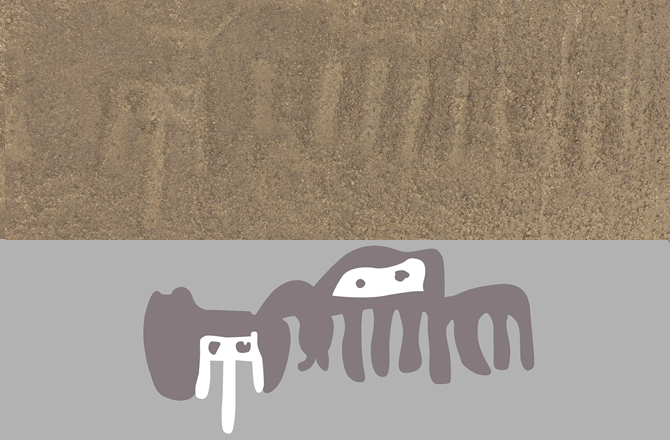Fascinating Research on the Nazca Lines

The Nazca Lines were again in the headlines earlier this month with the discovery of new glyphs by a team from Yamagata University, Japan. When the news crossed my Facebook feed, I realized I didn’t know much about the lines. So I started looking for more information.
The name Nazca was applied to this culture as early as 1912 by Thomas Joyce who, along with others, believed the Río Grande de Nazca drainage to be the center of this civilization1

Imaginative stories surround these etchings in the dirt. Some suggest religious backgrounds, navigation or marking the stars and seasons. I remembered reading “Chariots of the Gods” by Erich von Däniken, who claims to be “the world’s most successful non-fiction writer of all time, has written 55 books and e-media on the topic and has sold over 65 million copies worldwide”.2 In Chariots of the Gods , published in 1968, he suggested that the Nazca lines are the results of aliens landing ships.
He stated: “My idea was that some vehicle was coming down, not an interstellar spaceship, simply a small vehicle, and landing with an effect of an air-cushion system. So they don’t need landing tracks but simply, by the landing, itself some sand and stones are blown away and you have a simple track on the ground, and after a few hours or days, they start again and you have a second track”3
Even the History Channel, which sounds like a credible source, hosts a show called “Ancient Aliens” starring, Giorgio Tsoukalos in which aliens are credited with the creation of the Nazca lines. Giorgio states that the only way we can find the truth to the creation of these lines is if scientists from different disciplines will work together to find out their means and origins.4

I was certain that such research was being done. I found several collaborative efforts.
Many scientists from different disciplines have been studying the lines. Christina Conlee, Archeologist from Texas State University (TSU) has focused on the interactions between cultures and the disruption of one culture and reformation of another. She suggests that the lines were used by more than one culture, as they overlap and change over time.5 She works through the Anthropology department of TSU.
Another scientist working in the area is Bernard Eitel, geo-morphologist.6 He and his colleagues compose an interdisciplinary working group have studied the radiocarbon ages of snails found in the desert, as well the environmental evolution of the Nazca area. His work focuses on changes in geology over time.
The Nazca area was originally an area under ancient seas. The fossilized remains of small organisms formed the limestone that is common in southern Peru (so common that it is being mined)6 After the seas receded, volcanos erupted, scattering small dark stone debris across the white limestone. To create the Nazca line, the dark stones are removed and placed along the edges. This prevents dust from covering the lines as quickly.
Beyond the basic understanding of why the lines are visible, Eitel noted something else. There should have been unbroken fields of volcanic debris, but on the foothills were slumps of pale dust. These are called loess. When the winds blow, dust settles behind stands of grass, and those mounds of sand and dust are called loess. Another question arises; In this desert area, where was the grass?
Digging into the loess, Eitel found snail shells. These were in areas where there is less than 10 minutes of rain per year! Snails only live where there is plenty of water. The radiocarbon dating of the snail shells has given new perspective to the times in which the Nazca lived.

When the Nazca lines were formed, the area had quite a different climate. There was vegetation; brush and grass. Animals were plentiful for the hunters.
Early Nazca lines were of monkeys, hummingbirds, and even whales.
The area had changed previously. The seas had dried up. Aridification continued its advance. Farming began to be difficult. This was part of the environmental evolution of the area7.
In response, the people changed and the lines changed. They began to work more geometric lines. Some began to represent mazes. Clive Ruggles and Nicholas J. Saunders, two men who set out to do statistical analysis on the lines found some lines were not easy to discern as Nazca figures. They found one set of lines that they described by saying,
“its overall design is asymmetric and, as viewed ‘externally’, is completely unaesthetic— at least to Western sensibilities. It is certainly not representational in any obvious sense, and does not correspond to any motif known from Nazca iconography A ‘bird’s eye’ view is useless for understanding the meaning of the design; a sense of participating in a meaningful activity only emerges by walking. The design itself directs the walking experience, while the structure (i.e. the width of the path and the nature of the surface) shapes that experience for the mind and body”
This is a way of experiencing the lines, not just finding them aesthetically pleasing, but to actually interact with the lines in a meaningful way – by walking them. 8
The Japanese are also studying the lines and figures, some of which appear as ‘mythical figures.9

However ‘mythical’ the figures might be, scientists like Helaine Silverman and Donald Proulx who wrote the book, “The Nazca” will continue working with colleagues from around the world to “traces the history of archaeological research to sort out fact from fiction, examine Nazca society, politics, art and religion” 10
Giorgio and Erich might be surprised at the number of scholars working together to determine how the Nazca lines were actually created.
References
- http://people.umass.edu/proulx/online_pubs/Nazca_Overview_Zurich.pdf
- http://www.daniken.com/e/
- http://ancientaliensdebunked.com/references-and-transcripts/nazca-lines/#sthash.HvMlmHne.dpuf
- https://www.youtube.com/watch?v=MPXJB12iXls
- http://www.txstate.edu/anthropology/people/faculty/conlee.html
- http://www.prnewswire.com/news-releases/large-peruvian-limestone-aggregate-lime-claim-reported-300119584.html
- Geoarchaeological evidence from Desert Loess in the Nazca Palpa Region of Southern Peru: Paleoenvironmental changes and Their Impact on Pre-Columbian Cultures B. EITEL et. al. Achaeometry, Volume 47, Issue 1, pages 137–158, February 2005.
- http://www2.le.ac.uk/offices/press/press-releases/2012/december/new-light-on-the-nazca-lines
- http://www.foxnews.com/science/2016/05/03/experts-unearth-new-mythical-beast-nazca-lines.html
- http://www.wiley.com/WileyCDA/WileyTitle/productCd-0631232249.html




